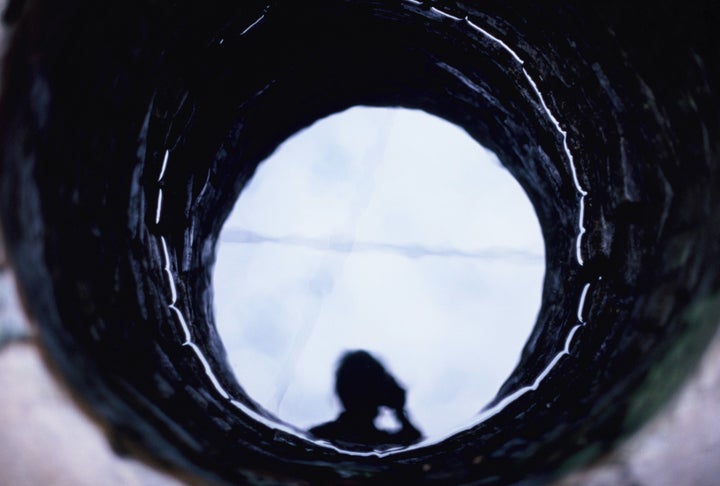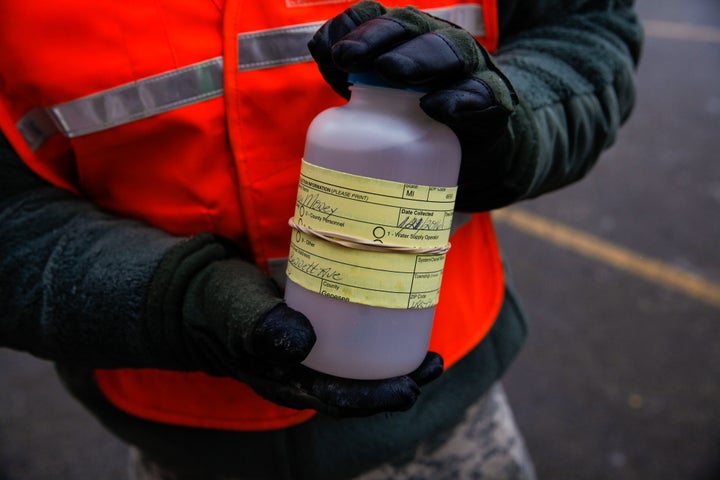ORLEANS, N.Y. (Reuters) - In this town of 2,800 just south of the Canadian border, residents have long worried about the water flowing from their taps.
The water in one household is so corrosive it gutted three dishwashers and two washing machines. Another couple’s water is so salty the homeowners tape the taps when guests visit. Even the community’s welcome center warns travelers, “Do Not Drink The Water.”
So, when the water crisis in Flint, Michigan happened, Stephanie Weiss and husband Andy Greene feared that, as in Flint, their corrosive water was also unleashing lead into their tap water. Weiss scoured water-testing reports in Orleans and discovered the truth: Lead levels in her water – fed by a private well – exceed the threshold set by the U.S. Environmental Protection Agency for public water systems and utilities.
The community’s experience is not unique. Across the country, millions of Americans served by private wells drink, bathe and cook with water containing potentially dangerous amounts of lead, Reuters reporting and recent university studies show.

Researchers from Penn State Extension and Virginia Polytechnic Institute and State University, or Virginia Tech, tested private well systems in their states and found that 12 percent of wells in Pennsylvania and 19 percent in Virginia had lead levels exceeding the maximum EPA threshold for public water systems. Lead poisoning can lead to heart disease, kidney disease and brain damage. It is especially dangerous to children, as small amounts of exposure can cause irreversible developmental delays.
Though most Americans are served by public water utilities, private wells are the main source of drinking water for 15 percent of U.S. households, or 47.8 million people. Typically located in rural areas, private wells serve residents not connected to municipal water lines. Though many wells are found in impoverished communities, some serve wealthy homeowners and those living in urban environments.
Little research has examined the lead risk in private well water on a national scale. But if the researchers’ rate played out nationally, more than 9 million Americans served by private wells would have unsafe levels of lead in their water, according to a paper published in October by some of the same Virginia Tech researchers who found lead in Flint’s water.
TESTING GAP
Yet these private wells always fall outside EPA testing regulations, and only a few states require that wells be tested for lead. Unless residents pay for tests, they may not know what lurks in their water.
The community in Orleans, in Jefferson County dotting the northernmost tip of New York State, is one case study. Weiss and Greene found that the water they use to cook for their two children, ages eight and 10, measured lead levels more than double the EPA threshold, town records show.
“When I realized that my water had the equivalent of Flint levels of lead, I got chills,” said Weiss, assistant director of Save the River, an environmental advocacy organization. “I felt sick thinking of all the things I had tried to get right as a mother for my kids to grow up happy and healthy, when all the while they were living with lead contaminated water.”
“I was also angry thinking that the state government had likely caused this situation.”
The aquifer feeding their well is polluted with salt from a nearby barn used by the New York State Department of Transportation to store salt spread on roads during snowstorms, according to an analysis by Alpha Geoscience, a Clifton Park, New York, consulting firm that specializes in hydrogeologic studies. The study was commissioned by Stephen Conaway, a local winery owner who sued the state for allegedly polluting his water in 2011.
As far back as 2004, a DOT official told Conaway it was not unreasonable to assume the salt barn was the source of contamination, according to a letter sent to Conaway and reviewed by Reuters.
Flint is not served by private wells, but its battle to get the lead out of the water has triggered alarms in other communities – including those served by private wells, which can draw in corrosive water that leaches lead, copper and other heavy metals from well components, water pipes and plumbing fixtures.

NO STANDARDS
The EPA has no standards for private wells, even as the National Ground Water Association recommends testing. Asked about the standards gap, an EPA spokesman said that the Safe Drinking Water Act, as written by Congress in 1974, makes the EPA responsible for regulating only public water systems.
Under the EPA Lead and Copper Rule, published in 1991, if 10 percent of samples taken by a water utility contain a lead level of 15 parts per billion or higher, the utility must improve corrosion control and inform the public of the lead risk. The utility may have to replace lead water lines.
The university researchers used this standard to assess potential harm in communities served by private wells.
Water from one Virginia home had lead levels 1,600 times the EPA maximum threshold, concluded Virginia Tech researcher Kelsey J. Pieper, lead author of a study published in the Journal of Water and Health last September that examined lead levels in tap water from houses in Virginia using wells. Pieper’s research, along with a 2013 Journal of Environmental Health study by Penn State Extension researchers, point to a problem governments have largely failed to address.
Lead exposures decreased after 1980s legislation banned lead in paint and gasoline. But private wells remain a potential source of exposure. If lead exposure from private wells is not addressed, the Centers for Disease Control and Prevention will be challenged to meet its goal of eliminating elevated levels of lead in children by 2020, Pieper found.
Pieper said many private wells across the country have clean water, but she recommends testing.
“Looking at lead concentration in Flint’s water and our results in private wells in Virginia, they were similar,” Pieper said. “One of the biggest differences is it’s solely the responsibility of the homeowner to identify and correct the problem for private water systems.”
To be sure, private homeowners are responsible for testing and maintaining their wells.
Yet many have no idea they should test for lead. Some who do test find troubling answers.
LEAD AND CHILDREN IN PENNSYLVANIA
In central Pennsylvania, Jeremiah Underhill and his wife took their one-year-old son Dalton to the family doctor for his checkup in April 2014. Knowing the family was renovating their 76-year-old house, and concerned paint in the house may contain lead, their doctor suggested testing Dalton for lead.
The results showed elevated lead levels in his system.
“I was devastated,” said Jeremiah Underhill, an attorney in Harrisburg, whose family home is surrounded by 30 acres of corn and soybean fields.
The Underhills immediately began a battery of tests searching for the lead’s source. For years, public health experts have cited paint as the most dangerous source of poisoning for children, who may ingest paint chips and dust in older housing.
But it was a water sample, not paint, which tested positive for lead. The lead level in the water was at the maximum threshold set by the EPA, though Penn State analysts warned that the levels could fluctuate and may well exceed the maximum if tested more regularly. The Underhills found that, as in Flint, their well water was corrosive and leaching lead from plumbing in their house.
The family installed a treatment system to make the water less acidic. Their soda-ash injection system cost about $400, though if a family member had not helped install it, the cost would have been far higher. Today, their water has no lead and Dalton’s blood work is clear. The couple feels fortunate to have caught it early, knowing lead exposure can trigger brain damage.
“The only reason we caught this was because our doctor was smart enough to say, ‘Let’s test this,’” Underhill said. “I mean, it was the water we used to mix Dalton’s formula.”
Most children are never tested, and rules on testing children for lead exposure are inconsistent and often ignored across the country, Reuters found.
“Many physicians, wrongly, don’t believe that lead poisoning is still a problem,” said Dr. Jennifer Lowry, a toxicologist and pediatrician at Children’s Mercy Hospital in Kansas City, Missouri. “They may not be seeing it because they are not testing for it. I think every kid should be tested.”
SURPRISING SOURCES
Many people believe if they have a new home or well, their plumbing does not contain lead. Yet virtually all plumbing before 2014 has some lead in its components, and older homes tend to have more leaded plumbing. Until January 2014, “lead free” meant the plumbing component contained less than 8 percent lead.
In Highlands, North Carolina, Robert and Suzanne Gregory discovered lead in their water after drilling a well for their home last August.
Macon County required they test the new well for bacteria. Robert, an engineer, wanted to know more and paid for an in-depth test that found the water corrosive and contaminated with lead. He believed the source was the galvanized steel pipe that ran down his well. The couple had the galvanized pipe, whose coating may have contained lead, replaced with lead-free stainless steel. They tested again and the lead was gone.
“The combination of acidic water and galvanized steel is a problem, and I think it’s bigger than most people understand because most people don’t even know they have galvanized,” Robert said.
Even if a homeowner conducts a lead test, the solutions can be too expensive for families with limited means. Some water treatment systems cost more than $10,000.
Only a few states, including New Jersey and Rhode Island, require wells be tested for lead – a test required when the property and well are transferred to a new owner. Though many states require tests for e coli and other bacteria, lead tests are seldom required, said John Hudson, vice president at Mortgage Financial Services in San Antonio, Texas.
A PLEA FOR CLEAN WATER
Some residents know they have contaminated wells and want municipal water, but can’t get it.
In Orleans, New York, residents live in a region known for its boating, fishing and outdoor activities but also its doggedly high unemployment rate. The town began petitioning the state for municipal water four years ago. Since then, residents have made flyers and set up a Facebook page, but there’s still no plan in place for public water.
State officials say they aim to obtain $13 million to extend municipal water service to homes in Orleans with contaminated water, but Kevin Rarick, the Orleans town supervisor, calls the plan “smoke and mirrors.” Almost all of the money would come from a loan that would cost each water user $500 a year to pay off, and the state has not announced a plan to change the way it stores salt at the barn.
Homeowner Greene, whose family has had to replace salt-tainted appliances, views the equation as unfair: The state polluted the aquifer feeding his well, and now wants his community to bankroll the solution.
New York State's Department of Environmental Conservation said the source of the salt is “inconclusive,” and that the salt has been stored safely. An official noted that the state has given residents bottled water.
“If I had a salt pile that leached salt into my neighbor’s well, the state would be here the next day fining me and making me clean it up and making me be a good neighbor,” said Greene. “That’s all we want from them, to be a good neighbor.”
